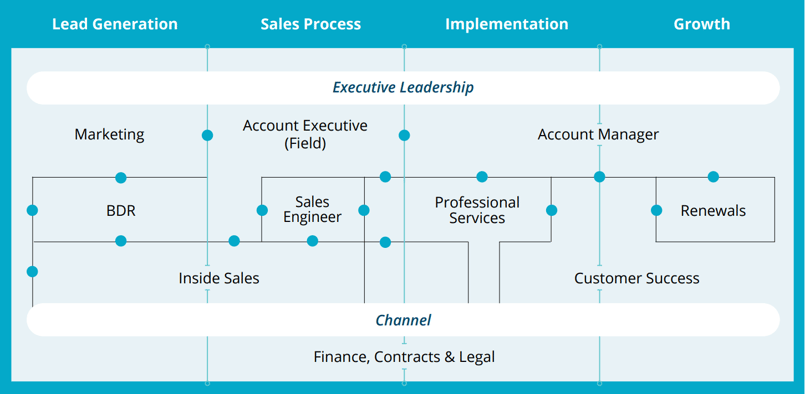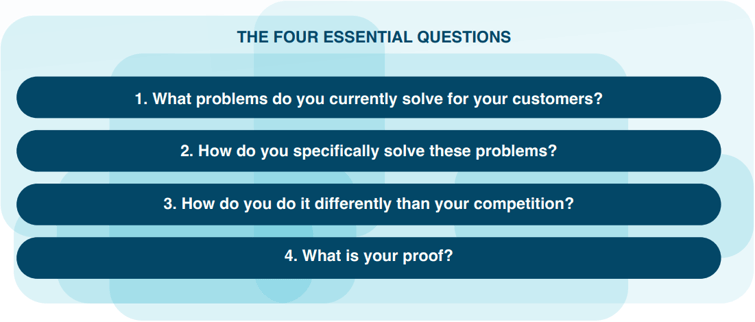
Cross-Functional Sales Teams: Improving Execution and Growth
Categories: Sales Transformation | Company Alignment | Sales and Marketing
In today's highly competitive market, it's no longer enough for a sales organization to differentiate itself solely based on its offering. The most successful companies today are those that create differentiation in their initial sales process and the customer’s journey. That level of execution requires that leaders enable every customer-facing team and role to be fluent in a unified sales message, strategy, and execution.
The result is a customer engagement process that is in sync with the way your customers buy, making it easier to align their requirements and business outcomes. When multiple functions collaborate to help customers uncover new ways to address their business challenges, the team rises above being just a solution provider and becomes a partner for growth.
Let’s explore four areas where leaders can establish greater cross-functional process alignment to ensure that sales strategy execution happens across the entire revenue organization. For more in-depth strategies, check out our leadership guide on Driving a Revenue Mindset.
1. The Customer Journey
In the modern sales landscape, a customer’s first interaction with your company is not always through sales. Your team must be able to create a consistent experience that reinforces your value across all cross-functional customer touchpoints.
Assess – how consistent is your strategy and value message across all of these handoff points in the customer journey?
A seamless customer experience starts with the executive team. Ensure your leadership is aligned on priorities and messaging and that these concepts are communicated consistently across the organization.
Help your sales team identify opportunities to involve other teams in the sales conversation; for example, customer success may be able to help with risk reduction and negotiation in conversations with implementation owners during the sales process. Marketing can strategize on content that helps sellers arm their Champions with proof of your value needed to gain buy-in internally. Ensuring communication and consistency of expectations across your internal teams has the potential to transform the customer experience and further differentiate your organization. We dive into strategies for establishing cross-functional execution consistency in this guide.
2. Value-Based Messaging
Your salespeople might be having value-based conversations, but what about your broader revenue team? If Sales is communicating value but your Sales Engineer and Customer Success teams aren’t able to convey your solution in terms of the customer’s positive business outcomes, the sales pitch may fall flat.
Consider how the different customer-facing teams in your revenue organization would answer these four questions. How can you better generate cross-functional consensus on these answers?
Within your leadership team, determine what conveying your value looks like for each customer-facing function. Is Marketing creating content that communicates your customer’s challenges and ideal outcomes? Does Sales consistently execute a discovery process that uncovers specific pain points and allows them to influence the solution requirements? As deals progress, it will be important for Administrative teams to understand how the terms and logistics of their role will impact how the customer receives value. The customer’s expected value should be communicated and conveyed by various teams throughout post-sale implementation and through ongoing engagement.
3. Continuous Qualification
It’s likely your sales team is already utilizing a qualification system like MEDDICC. Consider how involving the broader revenue team can help you attract, qualify and progress deals more efficiently. Also think through how they're qualifying renewals and cross-sell opportunities. When leadership clearly defines what a great deal looks like for all departments and how benchmarks are enforced, qualification criteria can be applied more consistently across the lifetime of a deal and grant greater visibility into deal status and forecast.
Improve the Sales team’s execution of MEDDICC by getting managers and sellers aligned on how your qualification criteria looks in action to ensure benchmarks are met before progressing deals forward. This alignment extends to Customer Success who can apply this data to cross-sell and upsell opportunities. Provide your Administrative teams with a workflow for communicating early on what a great deal looks like from a logistical perspective, to ensure all customer-facing roles are communicating consistently with the buyer.
4. The Negotiation Process
Sales negotiation is too often regarded as an event, rather than an ongoing process. In fact, the most productive sales negotiation strategies involve multiple cross-functional teams. Start by defining a cross-functional strategy for negotiation and provide guidelines for how information is shared and when certain teams should get involved.
First, it’s important to ensure your Sales team is negotiating early and often in order to shape, rather than fit, solution requirements. Your team can begin shaping the business conversation even earlier when Marketing strategizes content that reframes buyer pain in terms of your value offering. Customer Success can also help guarantee a strong delivery by negotiating high-leverage success activities and measurements. Administrative teams should participate in joint negotiation with Sales when it comes time to set deal terms, ensuring consistency in what’s promised to maintain leverage.
Unlock a Cross-Functional Execution Mindset
The key to mobilizing an effective cross-functional revenue team is a unified mindset. When all factions of your broader revenue team operate in congruency, it opens the door to greater and more efficient execution of your core strategy. Our leadership guide Driving the Revenue Mindset shares even more strategies for how to align commercial teams within your organization on the specific ways they create and capture value. Download it now and get started on your strategy for cultivating a customer experience that drives lasting revenue outcomes.


